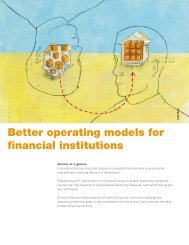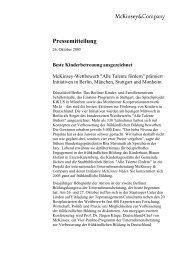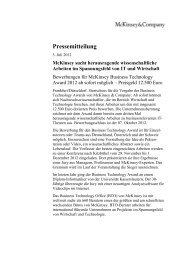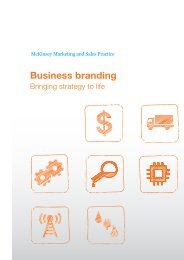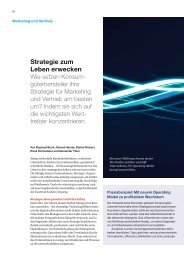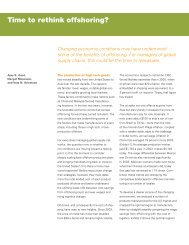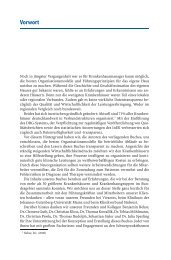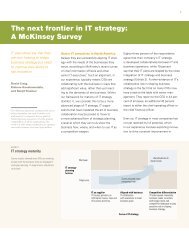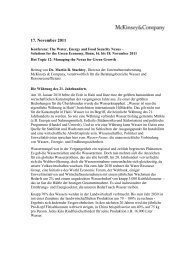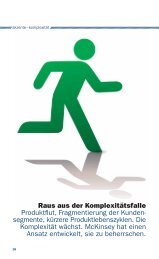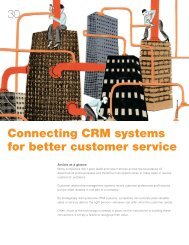Measuring success - McKinsey & Company
Measuring success - McKinsey & Company
Measuring success - McKinsey & Company
Create successful ePaper yourself
Turn your PDF publications into a flip-book with our unique Google optimized e-Paper software.
etween asset-backed and proprietary<br />
trading activities is managed by clearly<br />
separating them.<br />
• An integrated trading-focused model<br />
in which trading is responsible for the<br />
commercial optimisation across the entire<br />
value chain and portfolio. They participate<br />
in all asset/contract and retail activities<br />
from hedging in the medium to long term,<br />
short-term, asset-backed trading, as well<br />
as structured products/origination including<br />
procurement. The extent of proprietary<br />
trading activities depends on the overall<br />
risk appetite. However, certain activities<br />
are always performed to gain market access,<br />
conceal own-asset positions or generate<br />
market insights.<br />
Opportunities to create value through<br />
sophisticated trading and risk management<br />
capabilities are high – when you do it right.<br />
The best-performing, trading-focused players<br />
are able to add significantly more than 50%<br />
on top of the intrinsic value of their generation<br />
portfolio compared with only up to 30%<br />
for the more classical utility-like players.<br />
In general, the overall trading productivity<br />
for independent and integrated tradingfocused<br />
companies is two to three times<br />
higher than for pure retail or even generation-focused<br />
players. Consequently, the latter<br />
companies are in high risk of losing not only<br />
market share but also their talent.<br />
Implications<br />
The energy trading performance benchmarking<br />
survey highlights many important questions<br />
that the players in this still relatively<br />
young industry are struggling with to define<br />
the future role and position of trading. In our<br />
view, three very important pieces of advice<br />
can be taken from the survey. They are:<br />
• Defining the role of trading. Define the<br />
ambition level with respect to the three key<br />
roles of trading, that is, optimising assets and<br />
portfolios through asset-backed trading; creating<br />
growth opportunities through proprietary<br />
trading; and creating growth opportunities<br />
through structured products/origination.<br />
• Designing the trading function. Choose<br />
the organisational design with respect to:<br />
the organisational set-up of trading within<br />
the group and the corresponding interfaces<br />
with generation and sales; and the organisational<br />
set-up within the trading unit itself, for<br />
Share of trading revenues<br />
Average % across participants Indexed<br />
Proprietary<br />
trading<br />
Asset-backed<br />
trading<br />
Structured products/<br />
origination<br />
example, front, middle and back office.<br />
• Assessing the gap in capabilities/resources<br />
and choosing the path to <strong>success</strong>. Understand<br />
the gap in terms of: skills, for<br />
example, trading, risk management and IT;<br />
performance management, for example,<br />
remuneration levels and incentive schemes;<br />
and systems, tools and processes. It then<br />
needs to be decided whether to implement<br />
the first two points above in a big bang<br />
or a sequential approach and whether it<br />
should be done organically or through joint<br />
ventures/acquisitions.<br />
In answering these questions, players need to<br />
understand that trading involves risk-taking<br />
and that, consequently, activities should only<br />
be expanded after the corresponding risk<br />
management capabilities have been developed<br />
and not the other way around.<br />
Given the great enthusiasm and feedback in<br />
the first round, the energy trading survey is<br />
being rolled out for the second round. In addition<br />
to the power and gas players that were the<br />
focus in the first round, we are planning to<br />
include players from both the financial community<br />
and the US in the second round.<br />
For further information, or to participate in the second<br />
round of the survey, please contact:<br />
Sven Heiligtag or Jörg Doege, <strong>McKinsey</strong> & <strong>Company</strong>,<br />
Email: sven _ heiligtag@mckinsey.com,<br />
joerg _ doege@mckinsey.com<br />
The other authors of the survey are Markus Böhme,<br />
Hervé Touati and Thomas Vahlenkamp.<br />
May 2007 energy risk 59<br />
5<br />
45<br />
50<br />
Compensation vs. productivity<br />
Compensation*<br />
per trader<br />
100<br />
80<br />
60<br />
40<br />
20<br />
0<br />
Proprietary<br />
trading<br />
Asset-backed<br />
trading<br />
0 50 100<br />
Productivity**<br />
F4. Risk management capabilities frequently do not<br />
keep up with expanding trading activities<br />
* Including fiexed compensation and bonus payments<br />
** Net trading revenues per trader<br />
Source: <strong>McKinsey</strong> Energy Trading Performance Benchmarking




